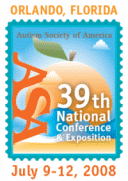 |
The ASA's 39th National Conference on Autism Spectrum Disorders of ASAThe Westin Kierland Resort & Spa, Scottsdale, AZ |
| For a complete author index with session numbers, please click here | |
| Friday, July 11, 2008: 1:45 PM-3:00 PM | |||
| Sun Ballroom 2 | |||
| #3571- Our Journey Continues to Eliminate the Use of Physical Restraints | |||
| This session will take the participants through the 4 year journey of the Winchester Region of Grafton to eliminate the use of physical restraint. It will describe how we established goals, created a culture of respect for the individuals we serve, generated the support and enthusiasm of Direct Support Professionals who supported our clients. This session will also focus on data, positive results (planned and unplanned), and lessons learned. | |||
| Presenters: | - Kimberly Sanders, Executive Director, Grafton’s Winchester, VA region, has assisted individuals with autism and other developmental disabilities for over 20 years. She is recognized as an innovator for moving towards a physical restraint-free environment. An active member of NARPAA, Kim has a B.S. in Psychology and a M.S. in Strategic Leadership.
- Stacey has supported individuals with Autism and other developmental disabilities for over 20 years. She has expertise in supporting adults using programs to build healthy interdependencies and encourage community integration. She is currently an Adult Services Administrator at Grafton School in Winchester, VA. She is an active member of NARPAA. | ||
|
| |||
|
In some cases individuals with Autism or other developmental disabilities also experience behavioral challenges such as physical aggression towards others and/or self injurious behavior. The acts of aggression come in various degrees of intensity; however, one thing typically remains constant. The factor that is constant is that the physical aggression is a form of communicating when other means are not available or are not effective. Regardless of the intent, historically in the Grafton has served individuals with Autism and other developmental disabilities accompanied by challenging behaviors for almost fifty years. Over the years we have used various de-escalation strategies, however, when those failed physical restraint was used to maintain safety. An example of one of our highest months of data was in 2003. We had 260 physical restraints for a total duration of 3800 minutes. During the summer of 2004, our Chief Executive Officer mandated that we move toward the elimination of physical restraint by January 2007 with the understanding that no one’s safety could be compromised. That is where the journey began. Today we have a feeling of success. In October 2006 we had 1 physical restraint for a total duration of 30 seconds. We have also had 3 months with 0 physical restraints. The population of the individuals we serve has not changed and our census has remained stable over the 4 years. (Please see inserted graph detailing decline in physical restraints.) During the first half of this session the speakers will take the participants through the beginning of the 4 year journey of the Winchester Region of Grafton School to eliminate the use of physical restraint. It will provide actual examples of how we established goals, created a culture of respect for the individuals we serve, and generated the support and enthusiasm of Direct Support Professionals who supported our clients. The following are the steps that were taken which will also be some of the learning objectives for this session: 1. Plan the Work and Work the Plan-Designing a realistic action plan 2. Communicate, Communicate, Communicate-Providing multiple avenues and forums to disseminate information 3. Reporter on the Street-Identifying influential staff to help spread the word and get feedback. This helped to build support for the initiative and employees really felt that they were able to give input on the process. 4. Comprehensive Assessments-Identifying individuals who were at high risk for the use of physical restraint and completing evaluations which included emphasis on medical issues. 5. Alternative Strategies-Providing training to everyone on alternatives strategies. This proved to be extremely important as employees must have replacement tools when the only tools they know are being eliminated. 6. Support by Presence- Ensuring that management, administrators, and the director provide support through their presence. This means actually working evening, weekend, and overnight shifts. 7. An Avenue for Learning-Implementing a debriefing process when a physical restraint does occur. The process is supportive and focused on sharing learnings instead of placing blame. The second part of this session will examine in great detail the actual physical restraint data and the various methods used at Grafton to analyze it to achieve positive outcomes. We will discuss the many lessons learned and other positive results (both planned and unplanned). One of the major planned positive results was that while our physical restraints decreased so did our Workers’ Compensation claims (See chart below). We will present this data and speak to the manner in which this result was achieved by the program team working closely with the risk management department. The primary learning that we would like others to take away from this session is that physical restraint is not the only answer. Other alternatives are just as effective and much safer. We want others to be encouraged to take our learnings back to their organization and eliminate the use of physical restraint. |
|||
See more of General Submissions
See more of The ASA's 39th National Conference on Autism Spectrum Disorders